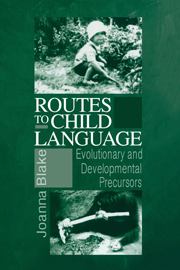Book contents
- Frontmatter
- Contents
- Preface
- 1 Prelinguistic Vocalizations
- 2 Sound–Meaning Correspondences
- 3 Communicative Gestures
- 4 Symbolic Gestures and Symbolic Play
- 5 Tool Use and Object Concept
- 6 Representation in Human Infants
- 7 Memory in Nonhuman Primates and Young Children
- 8 Origins of Language
- 9 Recapitulation
- References
- Index
1 - Prelinguistic Vocalizations
Published online by Cambridge University Press: 12 January 2010
- Frontmatter
- Contents
- Preface
- 1 Prelinguistic Vocalizations
- 2 Sound–Meaning Correspondences
- 3 Communicative Gestures
- 4 Symbolic Gestures and Symbolic Play
- 5 Tool Use and Object Concept
- 6 Representation in Human Infants
- 7 Memory in Nonhuman Primates and Young Children
- 8 Origins of Language
- 9 Recapitulation
- References
- Index
Summary
Among the most intriguing aspects of human language is its sound system and how the human infant comes to acquire it. Three major questions are addressed in this chapter. First, are there any similarities to be found between features of animal vocalizations and those of early infant vocalizations? In other words, can possible phylogenetic origins of human infant vocalizations be found in the vocalizations of nonhuman primates? If so, where exactly is the overlap? Alternatively, are even the earliest stages of human infant vocalizations quite distinct from animal vocalizations? Second, what are the major developments in the early ontogeny of the human vocalization system, and do they vary across infants with different characteristics or backgrounds? The focus here is on such features of vocal development as the onset of canonical (reduplicated) babbling, phonetic preferences, consonantal repertoire, consonantality (degree of consonant use), and complexity (combination of different consonants). Third, do variations in features of babbling across infants make a difference in language acquisition? Is just babbling itself an important precursor to language, or is the quality of babbling also important?
In this chapter, infant prelinguistic vocalizations are considered to be all phonated sounds (with vibration of the vocal cords) that are audible and are not crying, fussing, laughing recognizable words, imitated animal sounds, or imitated conventionalized expressions (uh-oh). These criteria are consistent with those used in most research on early infant vocalizations except that some researchers exclude also grunts (for example, Oller & Lynch, 1992) and some include words (for example, Vihman & Greenlee, 1987).
- Type
- Chapter
- Information
- Routes to Child LanguageEvolutionary and Developmental Precursors, pp. 1 - 41Publisher: Cambridge University PressPrint publication year: 2000



